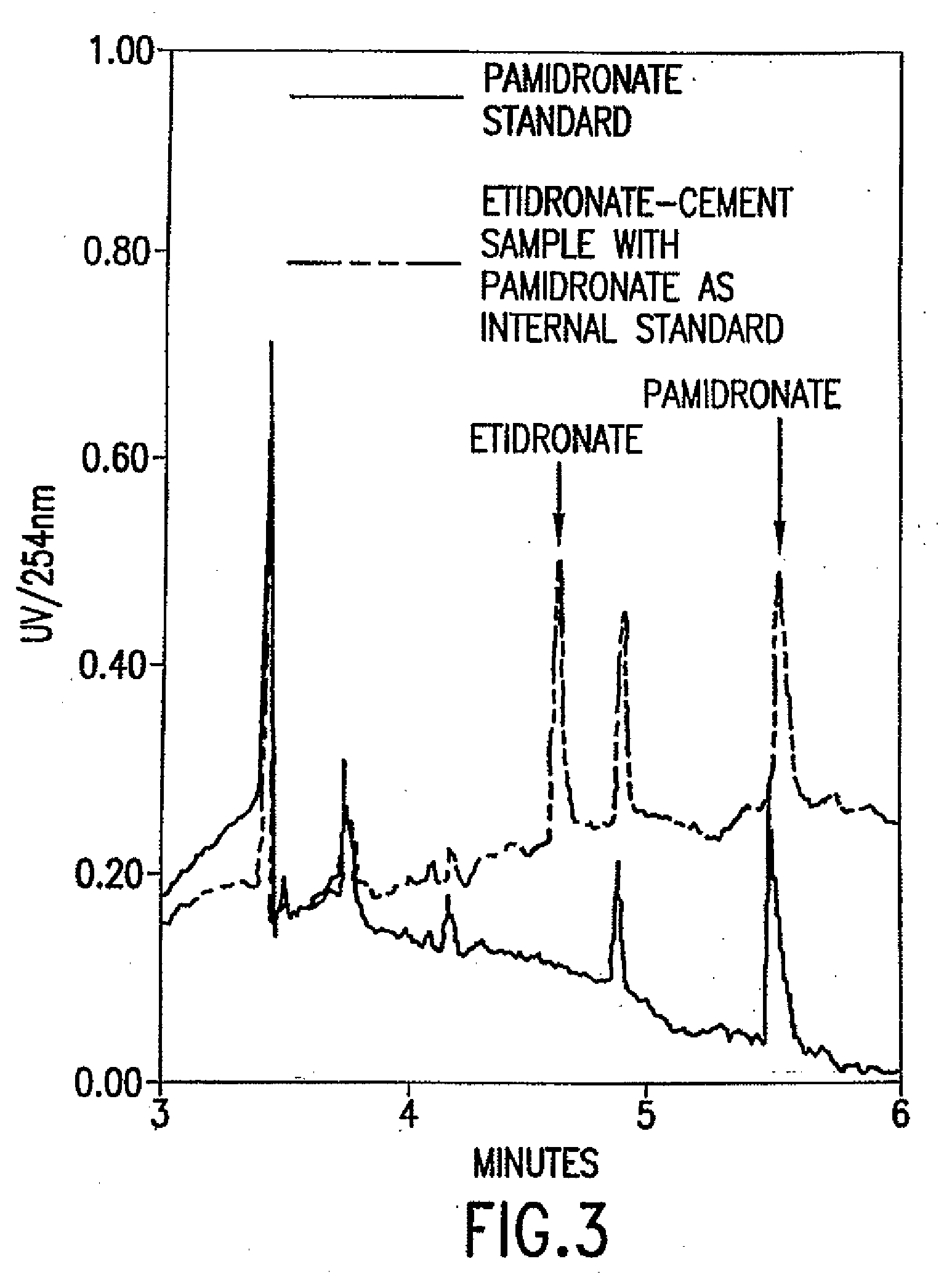Anti-resorptive bone cements and allogeneic, autografic, and xenografic bone grafts
a technology of anti-resorptive bone cement and allogeneic autografic bone grafts, which is applied in the direction of phosphorous compound active ingredients, biocide, surgery, etc., can solve the problems of patients losing function, affecting the durability of implant fixation, and significant health care costs
- Summary
- Abstract
- Description
- Claims
- Application Information
AI Technical Summary
Benefits of technology
Problems solved by technology
Method used
Image
Examples
example 1
Evaluation of the Biomechanical Characteristics and Drug Delivery Potential of PMMA Impregnated With Bisphosphonates
[0208]Biomechanical testing was carried out on PMMA impregnated with each of etidronate disodium and pamidronate disodium. All of these tests were performed using Howmedica's Surgical SIMPLEX® PMMA cement.
[0209]Each test was performed 10 times, as required by the United States FDA. FIGS. 1 and 2 summarize the results of compression tests on the PMMA impregnated with each of etidronate disodium and pamidronate disodium.
[0210]For all the tests, the PMMA powder (basis: 40 grams) was blended with the bisphosphonate drug using a rotary tumbler mixer for 30 minutes. Drug levels that were selected for these tests, e.g., 0.5, 1.0, 1.5, 2.0 gram / 40 grams PMMA, are similar to published antibiotic drug levels (Duncan, et al., supra).
[0211]The final determination of the drug level will depend upon the elution profile of the drug from the polymerized drug-cement matrix. The blend s...
example 2
Drug Level Analysis
[0214]Drug level analysis can be performed by the following techniques: capillary electrophoresis, HPLC and fluorescence spectrophotometry.
[0215]A method of analysis for pamidronate disodium and etidronate disodium samples from cement, bone and fluid samples using capillary electrophoresis (“CE”) technology is employed (Leveque, D., Gallion, C, Tarral, Monteil H., Jehl, F., “Determination of fosfomycin in biological fluids by capillary electrophoresis”, J. of Chromatography B., 655, 320-324, (1994); Olmstead, M. L., “Canine cemented total hip replacements: State of the art”, J. Small Animal Practice, 36, 395-399, (1995); Peng, S. X., Takigiku, R., Burton, D. E., Powell, L. L., “Direct Pharmaceutical Analysis of Bisphosphonates by Capillary Electrophoresis”, J. Chromatogr. B. Biomed. Sci. Appl., 709:1, 157-160, (1998)). The detection levels for these bisphosphonates are 1.0 microgram / milliliters.
[0216]Pamidronate disodium and etidronate disodium do not possess any ...
example 3
Determination of Elution Rates
[0224]An elution study was performed using pellets of pamidronate disodium-impregnated PMMA soaked with phosphate buffered saline at 370° C. The results of this study are presented in FIG. 4. Fluid samples were withdrawn and analyzed using fluorescence spectrophotometry. This technique is a simple and rapid approach for measuring pamidronate disodium. The samples are mixed with fluoraldehyde reagent (Fischer) and read in a fluorescence spectrophotometer whose excitation wavelength is 340 nm and whose emission wavelength is 460 nm. Concentration is determined using a standard curve.
[0225]A simple mathematical model based on the “Fick” diffusion principle is used to analyze the elution data (Law, H. T., Fleming, R. H., Gilmore, M. F. X., McCarthy, I. D. and Hughes, S. P. F., “In Vitro Measurement and Computer Modeling of the Diffusion of Antibiotic in Bone Cement”, J. Biomed. Eng., 8:2, 149-155, (1986)). The model parameters are used with a subsequent mat...
PUM
| Property | Measurement | Unit |
|---|---|---|
| Fraction | aaaaa | aaaaa |
| Fraction | aaaaa | aaaaa |
| Diameter | aaaaa | aaaaa |
Abstract
Description
Claims
Application Information
 Login to View More
Login to View More - R&D
- Intellectual Property
- Life Sciences
- Materials
- Tech Scout
- Unparalleled Data Quality
- Higher Quality Content
- 60% Fewer Hallucinations
Browse by: Latest US Patents, China's latest patents, Technical Efficacy Thesaurus, Application Domain, Technology Topic, Popular Technical Reports.
© 2025 PatSnap. All rights reserved.Legal|Privacy policy|Modern Slavery Act Transparency Statement|Sitemap|About US| Contact US: help@patsnap.com



